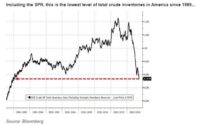Is It Time to Bet on an Inflation Overshoot? – MishTalk
At least two writers I follow, one in the US, the other in the EU, believe we are headed for an inflation overshoot. Neither is a permanent inflationista.

Betting on EU Inflation
Eurointelligence founder Wolfgang Münchau says Time to Bet on an Inflation Overshoot emphasis mine.
Our main story today is a skeptical note following [ECB head] Christine Lagarde’s press conference [on July 27]. What became clear to us is that the ECB is still reliant on its forecasting model to determine whether it is on a trajectory to reach the 2% inflation target. This is not a technical issue, but rather it is critical for the assessment of what to expect. Since this model is biased in favor of forecasting the target, we conclude that the potential for a policy error is growing.
The big problem with data dependence is that it does not tell you what you need to know. You may know that inflation is coming down, but you don’t know whether or not it is coming down to 2%. Lagarde told us yesterday that the ECB was using the forecast, or projection as they call it these days, to make that determination. That alone tells us that the ECB will from now on tread more cautiously, because the forecast is hard-wired to predict outcomes in the vicinity of the inflation-target. In particular, it makes the assumption that the sheer announcement of an inflation target anchors people’s expectations. We know this is not true, but it forms an essential element without which the framework would not work.
The problem with this policy rule is that it would give you the same answer regardless of whether your target is 2% or 3%.
It is interesting that central banks have never subjected their forecast performance to outside evaluation. The ECB’s model has been giving wrong forecasts for the last ten years. It is not the forecast error that is the problem, but the forecast bias. The model is biased in favor of the actual target. If your benchmark is biased in favor of the target, then it is biased in favor of a lower interest rate. The reason we are focused so heavily on discussions of the model here at Eurointelligence is because it is the main source of policy errors.
If this happened in finance or in political polling, these models would have been kicked out a long time ago, along with the staff that produce them. That is not happening in central banks, whose economists are attached to what they like to call their workhorse models.
In its update of its World Economic Outlook, the IMF also warned about the asymmetry of inflation. So did several economists like Olivier Blanchard, Kenneth Rogoff. Some of them may be open to the idea of a higher inflation target.
We conclude therefore that the risk of a permanent inflation overshoot at the ECB is high.
Structural Inflation
“Many cheering softening prices, but look at wages vs. productivity to understand the structural inflation pressures in the US economy.”
Everything Fine Camp
For good measure, ponder the No Landing scenario.
No Landing Definition
Inflation Expectations, Forward Guidance, Biased Models
- Forward guidance has been a disaster in both the US and Eurozone. People take every word of Central Bankers as if it Gospel when history shows they are clueless.
- The central bank models in the US and EU are biased in favor of the outcomes the central bankers want. That’s been easy to see for decades.
- Inflation expectations are nonsense. A look at components of the CPI shows the silliness of it all.
CPI Percentage Weights

Over 70 percent of the CPI consists of inelastic items.
People will not rent two houses now if they think prices are going up. They will not stop renting if they think prices will drop. The same applies to eating, medical care, insurance and car repairs.
What people expect is irrelevant at least 72 percent of the time. It’s greater in practice because I missed some items. For example, discretionary items also include clothes. If your coat wears out you tend to get a new one. The same applies to a washing machine. And you surely don’t buy two washing machines in advance even if you think the price is going up next year.
Finally, those with ample wealth or income do what they want regardless of price. Yet, the Fed and ECB wizards all believe in this expectations nonsense.
The one place exceptions matter pertains to asset bubbles. People will buy stocks and houses if they think prices are rising.
Curiously, the one and only place expectations matter is the one place the Fed never looks. This is how the Fed blows bubble after bubble of increasing amplitude.
Mercy Me! Inflation Expectations Are No Longer Well Anchored
Recall my July 14, 2021 post Mercy Me! Inflation Expectations Are No Longer Well Anchored
Here is the key chart at the time.

Expectations Fantasy
- For most of 8 consecutive years, year-over-year CPI and PCE was under 2%.
- In that same time frame, the Median 3-year estimate and the median point projections was seldom below 3%.
- If inflation expectations mattered, that chart would be impossible.
- Alternatively, one might say people believe low inflation is transitory.
- Yet, we constantly hear the Fed yapping “Inflation expectations are well anchored”.
It’s a good thing for the Fed that expectations don’t matter because 5+% expectations can no longer be considered well anchored.
Please note that the Fed was hell bent on producing inflation, and for 8 years people believed inflation would be 3 percent. However, the Fed struggled to produce inflation, so much so that the Fed wanted to make up for prior lack of inflation!
A Fed Economist Concludes the Widely Believed Inflations Expectations Theory is Nonsense
On October 1, 2021 I noted A Fed Economist Concludes the Widely Believed Inflations Expectations Theory is Nonsense
In addition to my analysis, a Fed study debunked both the Phillips Curve and inflation expectation theory, yet every person on the Fed believes in this nonsense.
They are all so biased in their own groupthink, they do not even pay attention to their own research and data.
What a hoot.
Four Measures of Inflation, What’s the Fed Watching the Most?

For a look at the most recent CPI and PCE numbers, please see Four Measures of Inflation, What’s the Fed Watching the Most?
The Housing Bubble, as Measured by Case-Shiller, Is Expanding Again
Also note that The Housing Bubble, as Measured by Case-Shiller, Is Expanding Again.
Meanwhile, the Fed is watching the PCE, seemingly oblivious to the massive asset bubbles in housing and the stock market that it helped create.
Productivity Dead Zone
Regarding productivity, Four to Six PM and Friday Afternoons Are a Productivity Dead Zone
What Now?
Bidenomics, EV mandates, and regulations are hugely inflationary. So are wage hikes without productivity gains.
At best, bringing down inflation is going to be a struggle unless either the economy or the stock market crashes.
Perhaps it could take both, and I do not rule that out.
[ad_2]
Source link


